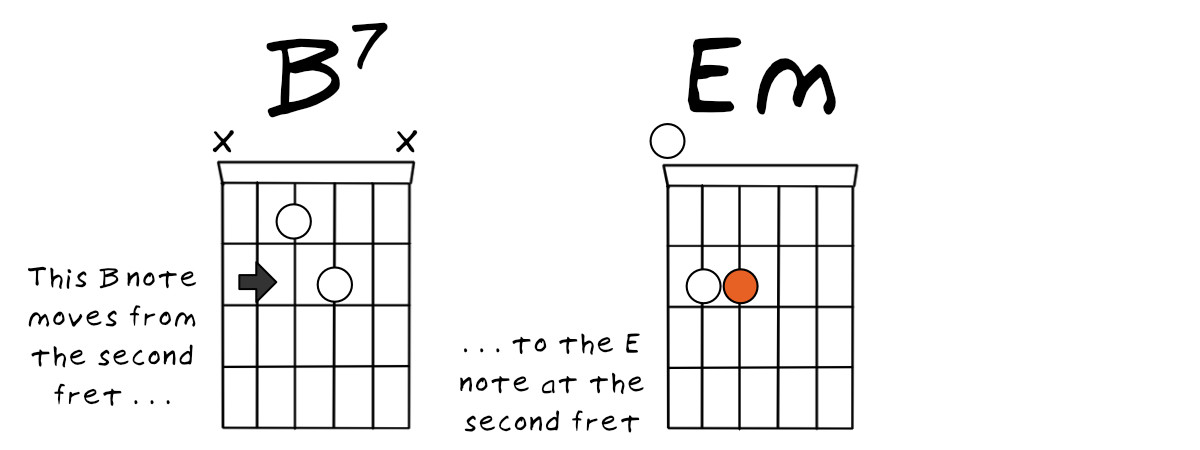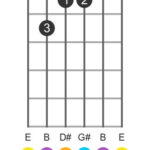Hearing “California Dreamin'” for the first time is often a memorable experience. The melancholic minor chords that open the song, followed by the iconic vocals of The Mamas and the Papas, create an atmosphere that’s both nostalgic and instantly captivating. While the song is relatively straightforward to play, there’s a clever musical trick hidden within its chord progression that contributes significantly to its distinctive and somewhat yearning quality. Let’s dive into the “California Dreamin’ guitar chords” and explore this fascinating element.
The Expected Turn: Dominant 7th Chords in Music Theory
To understand what makes “California Dreamin'” special, it’s helpful to grasp a fundamental concept in Western music theory: the behavior of dominant 7th chords. A dominant 7th chord (like E7, which appears in the song) creates a strong sense of anticipation and resolution. In traditional chord progressions, dominant 7th chords are expected to resolve to their “right-hand neighbor” in the circle of fifths.
For example, in the key of A minor/C major (the key of “California Dreamin'”), an E7 chord naturally wants to resolve to an A minor (Am) or A major (A) chord. This resolution feels natural and complete to our ears due to the inherent tension within the dominant 7th chord. Imagine a musical gravity, pulling the E7 towards its expected destination.
 Chord flow diagram showing the expected resolution of an E7 chord to an A or Am chord in standard Western music theory.
Chord flow diagram showing the expected resolution of an E7 chord to an A or Am chord in standard Western music theory.
The Unexpected Twist: E7 to F Major
However, “California Dreamin'” takes an unexpected turn. Instead of resolving the E7 chord to A or Am, The Mamas and the Papas move to an F major chord. This is a musical surprise, a deviation from the expected path.
 Chord progression from 'California Dreamin' showing the unexpected move from E7 to F major chord.
Chord progression from 'California Dreamin' showing the unexpected move from E7 to F major chord.
This move works because of the “leading tone.” The leading tone is the note in a dominant 7th chord that is just a half step below the root of the expected resolving chord. In E7, the leading tone is D#. This D# naturally “wants” to move up to E (the root of A minor/major). However, by moving to F, we are essentially taking that leading tone and moving it up a half step to E, which is part of the F major chord. This upward movement, while unexpected in the context of dominant 7th resolution, creates a unique and slightly unsettling feeling. It’s this unexpected shift that adds to the song’s dreamlike and slightly melancholic quality.
“Summertime” and Other Songs with a Similar Trick
“California Dreamin'” isn’t the only song to employ this clever chord trick. George Gershwin’s classic “Summertime” utilizes a similar technique. “Summertime” often moves between Em and Am chords, creating a gentle, swaying feel. Then, a B7 chord appears, which, according to standard chord flow, should resolve to Em.
 Chord flow diagram showing the expected resolution of an E7 chord to an A or Am chord in standard Western music theory.
Chord flow diagram showing the expected resolution of an E7 chord to an A or Am chord in standard Western music theory.
However, just like in “California Dreamin’,” “Summertime” surprises us by moving the B7 chord up a half step to a C major chord.
 Chord progression from 'California Dreamin' showing the unexpected move from E7 to F major chord.
Chord progression from 'California Dreamin' showing the unexpected move from E7 to F major chord.
In “Summertime,” this B7 to C movement evokes a sense of gentle relief, like a cool breeze on a warm day. This technique isn’t limited to pop and jazz; you can find similar examples in blues and even some classical music.
Conclusion: Experiment with Unexpected Chord Changes
The unexpected chord progression in “California Dreamin'” is a testament to the power of breaking musical conventions in subtle and effective ways. By moving from E7 to F, The Mamas and the Papas created a moment of surprise and harmonic interest that significantly contributes to the song’s unique character. As guitar players and songwriters, understanding these kinds of musical “tricks” can open up new avenues for creativity. So, next time you’re playing your “California Dreamin Guitar Chords,” listen closely to that E7-F transition and appreciate the subtle genius at play. And don’t be afraid to experiment with similar unexpected chord changes in your own music!

